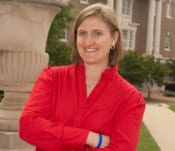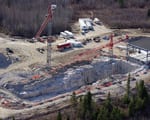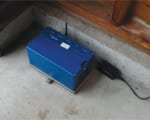Scientists report the Cryogenic Dark Matter Experiment has set more stringent limits on light dark matter
Scientists hunting for dark matter announced Friday they’ve now been able to probe the dark matter mass and cross section in a region that no other experiment has been able to explore.
Dark matter has never been detected, but scientists believe it constitutes a large part of our universe. Key to finding dark matter is determining its mass, or the volume of matter it contains.
On Friday, scientists with CDMS, a dark matter experiment that operates a particle detector in an abandoned underground mine in northern Minnesota, said they’ve narrowed the possibilities for dark matter’s mass.
The CDMS experiment searches for Weakly Interacting Massive Particles, which some physicists theorize constitutes dark matter. WIMPS are particles of such low mass that they rarely interact with ordinary matter, making them extremely difficult to detect, said physicist Jodi Cooley, an assistant professor in the Department of Physics at Southern Methodist University, Dallas, and a member of the experiment.
CDMS scientists say they’ve narrowed the range of measurements in which dark matter’s mass might occur.
“This new result is sensitive to WIMPs of lower mass than previous experiments have been able to attempt to measure,” Cooley said.
The result, however, conflicts with results from another experiment that is also hunting for dark matter. A handful of experiments around the world are using different techniques to solve the question.
“It’s not enough for one technique and one experiment to say they’ve made a discovery. It always has to be verified and looked at by another experiment, independently, with a different technique,” Cooley said. “If different techniques and different instruments prove the finding, then you can have a lot more confidence in the result.”
SMU graduate student Bedile Kara worked on the CDMS analysis. Kara performed the data processing and developed data quality and particle identification criteria used for the result.
Dark matter makes up the bulk of the universe, but know one has seen it
Scientists looking for dark matter face a serious challenge: No one knows what dark matter particles look like. So their search covers a wide range of possible traits — different masses, different probabilities of interacting with regular matter.
Scientists on the CDMS, which stands for Cryogenic Dark Matter Search, announced they have shifted the border of the search down to a dark-matter particle mass and rate of interaction that has never been probed.
“We’re pushing CDMS to as low mass as we can,” says physicist Dan Bauer, the project manager for CDMS at Fermi National Accelerator Laboratory, a U.S. Department of Energy national laboratory near Chicago. “We’re proving the particle detector technology here.”
The CDMS result does not claim any hints of dark matter particles. But it contradicts a result announced in January by another dark matter experiment, CoGeNT, which uses particle detectors made of germanium, the same detector material used by CDMS.
To search for dark matter, CDMS scientists cool their detectors to very low temperatures to detect the very small energies deposited by the collisions of dark matter particles with the germanium. They operate their detectors half a mile underground in an abandoned iron ore mine in northern Minnesota. The mine provides shielding from cosmic rays that could clutter the detector as it waits for passing dark matter particles.
Dark matter experiments attempt to understand dark matter despite background noise
Friday’s result carves out interesting new dark matter territory for masses below six GeV, a unit of energy for measuring subatomic particles. The dark matter experiment Large Underground Xenon, or LUX, recently ruled out a wide range of masses and interaction rates above that with the announcement of its first result in October 2013.
Scientists have expressed an increasing amount of interest of late in the search for low-mass dark matter particles, with CDMS and three other experiments — DAMA, CoGeNT and CRESST — all finding their data compatible with the existence of dark matter particles between five and 20 GeV. But such light dark-matter particles are hard to pin down. The lower the mass of the dark-matter particles, the less energy they leave in detectors, and the more likely it is that background noise will drown out any signals.
Even more confounding is the fact that scientists don’t know whether dark matter particles interact in the same way in detectors built with different materials to search for dark matter in more than a dozen experiments around the world.
“It’s important to look in as many materials as possible to try to understand whether dark matter interacts in this more complicated way,” says Adam Anderson, a graduate student at MIT who worked on the latest CDMS analysis as part of his thesis. “Some materials might have very weak interactions. If you only picked one, you might miss it.”
Scientists around the world seem to be taking that advice, building different types of detectors and constantly improving their methods.
“Progress is extremely fast,” Anderson says. “The sensitivity of these experiments is increasing by an order of magnitude every few years.”
Elusive dark matter — the “glue” that represents 85 percent of the matter in our universe — has never been observed. Cooley in 2012 was recognized by the National Science Foundation with its prestigious Faculty Early Career Development Award. The NSF awarded Cooley a 5-year, $1 million research grant toward her CDMS dark matter research. — Margaret Allen, SMU, and Kathryn Jepsen, Fermilab
Follow SMUResearch.com on Twitter.
For more information, www.smuresearch.com.
SMU is a nationally ranked private university in Dallas founded 100 years ago. Today, SMU enrolls nearly 11,000 students who benefit from the academic opportunities and international reach of seven degree-granting schools. For more information see www.smu.edu.
SMU has an uplink facility located on campus for live TV, radio, or online interviews. To speak with an SMU expert or book an SMU guest in the studio, call SMU News & Communications at 214-768-7650.



 NOvA experiment glimpses neutrinos, one of nature’s most abundant, and elusive particles
NOvA experiment glimpses neutrinos, one of nature’s most abundant, and elusive particles SMU scientists to deploy seismic monitors in North Texas region near Azle, Texas
SMU scientists to deploy seismic monitors in North Texas region near Azle, Texas Parents less likely to spank after reading briefly about its links to problems in children
Parents less likely to spank after reading briefly about its links to problems in children Wall Street’s short sellers wrongly maligned — detected red flags ahead of US financial crisis
Wall Street’s short sellers wrongly maligned — detected red flags ahead of US financial crisis A director’s skills, experiences and workload drive their compensation, SMU study finds
A director’s skills, experiences and workload drive their compensation, SMU study finds Gut reaction of marital partners could foretell their marriage satisfaction
Gut reaction of marital partners could foretell their marriage satisfaction Fossil supervolcano discovered in Italy by SMU-led team is now key feature of new UNESCO Geopark
Fossil supervolcano discovered in Italy by SMU-led team is now key feature of new UNESCO Geopark NPR: “Boiling Hot: How Fracking’s Gusher of Geothermal Energy is Wasted”
NPR: “Boiling Hot: How Fracking’s Gusher of Geothermal Energy is Wasted” KERA, NOVA: SMU researcher Peter Weyand discusses the upper limits of human speed.
KERA, NOVA: SMU researcher Peter Weyand discusses the upper limits of human speed.
 The Undying Radio: Familiarity breeds content when it comes to listeners and music
The Undying Radio: Familiarity breeds content when it comes to listeners and music